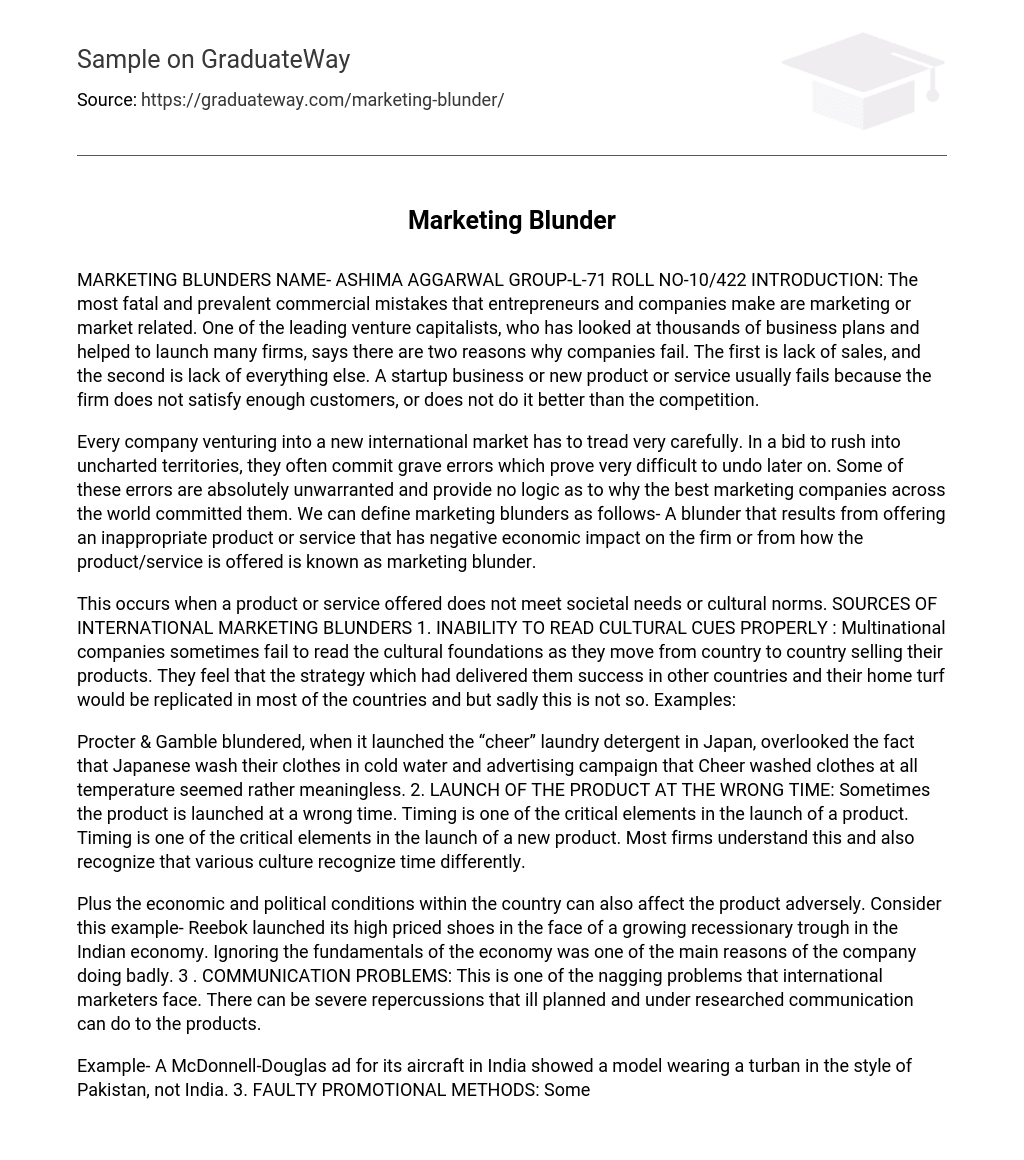INTRODUCTION
A venture capitalist who has reviewed many business plans and helped establish multiple enterprises states that the majority of significant mistakes made by entrepreneurs and companies are related to marketing or the market itself. These errors often lead to failure due to insufficient sales and inadequacy in other areas. Generally, a startup business, as well as a new product or service, fails if it does not meet customer demand or cannot outperform competitors.
When companies venture into new global markets, they must exercise caution as hasty actions can result in irreversible and significant errors. Even the leading marketing firms worldwide occasionally make illogical and unjustifiable mistakes. Marketing blunders refer to providing an inappropriate product or service that negatively affects the company economically or arises from how the product/service is presented.
This happens when a product or service provided fails to meet the needs and cultural expectations of society.
SOURCES OF INTERNATIONAL MARKETING BLUNDERS
Difficulty in accurately understanding cultural cues.
Multinational companies frequently fail to acknowledge the cultural disparities that arise when expanding into new countries to market their products. They often presume that the approaches which have yielded success in other markets and their home country will be equally effective in most places. Nevertheless, this is not always accurate. A notable example of this is Procter & Gamble’s misstep in Japan with their “cheer” laundry detergent. They neglected to consider that Japanese individuals wash their clothes using cold water, rendering an advertising campaign emphasizing Cheer’s efficacy at all temperatures irrelevant to Japanese consumers.
LAUNCH OF THE PRODUCT AT THE WRONG TIME
When introducing a product, it is important to consider timing as it can greatly affect its success. Different cultures have different perceptions of time, and the economic and political situations of a country can also play a role. For example, Reebok made the mistake of launching its expensive footwear during India’s recession, which had a negative impact on their performance. Ignoring these crucial factors significantly contributed to the disappointing outcome for the company.
COMMUNICATION PROBLEMS
One of the challenges faced by international marketers is the significant negative consequences that can arise from insufficient planning and research in communication practices. A prime illustration of this is seen in an advertisement by McDonnell-Douglas for their aircraft in India, where they mistakenly featured a model wearing a turban resembling the Pakistani style instead of the Indian style.
FAULTY PROMOTIONAL METHODS
Reebok sought to increase their shoe sales in India by enlisting the support of sports celebrities like Baichung Bhutia, a football player from Sikkim. However, this marketing strategy had minimal impact on sales due to the limited popularity of football in India outside of Bengal.
Without considering racial, national, or religious sentiments
Pepsodent’s experience serves as a warning for companies that ignore racial and religious sensitivities. When Pepsodent entered Southeast Asian markets, it advertised its teeth whitening feature with the slogan “Wondering where the yellow went”. Regrettably, this statement was seen as offensive.
Having difficulty understanding market trends
Product failures often occur due to a lack of understanding of market forces. When multinational corporations (MNCs) entered the Indian market, they underestimated its size. They assumed that the middle class in India consisted of a massive 200 million people, making it a potentially huge market for MNCs. However, these MNCs failed to realize that individuals with a monthly income of Rs. 40,000 were also considered part of this middle class group in India. Furthermore, many Indian women do not participate in the workforce, resulting in lower disposable income for the middle class than initially believed. Consequently, sales of consumer durables, automobiles, and luxury goods have fallen below expectations.
Reebok made a major misstep in the market by underestimating its customers. The company introduced its products in a flashy manner, opening fancy stores known as “infinity” and offering expensive shoes that were made in India by Phoenix International. Despite being a local product, the brand failed to consider that fitness is not a top priority for many Indians, and sports shoes are primarily seen as fashion accessories worn by young individuals. Furthermore, by setting exorbitantly high prices, Reebok alienated the majority of middle-class consumers who had more affordable options available from Liberty, Lakhani, and Action shoes.
Following a failed attempt, Reebok in Bangalore is organizing a sale as their second effort. In response to adverse outcomes, the company is revamping its strategy by lowering prices and emphasizing on delivering value for customers’ money.
STRATEGIC APPROACH TO INTERNATIONAL MARKETING
Before venturing into international marketing and entering foreign markets, conducting a strategic analysis is essential. This analysis serves the purpose of evaluating the viability and potential success of expansion. It entails a thorough examination of the marketing mix to ascertain its appropriateness in different international markets, which can be a time-consuming undertaking.
TEN TIPS TO AVOID MARKETING BLUNDERS
- Develop a marketing plan
- plan a marketing budget
- Target a specific audience
- Develop a clear and consistent marketing message
- Understand that your product will not sell itself.
- Clearly identify the product benefits.
- Expand your media mix
- Appreciate the lifetime value of a customer
- Have a matching revenue program
- Try to up-sell the customer.





